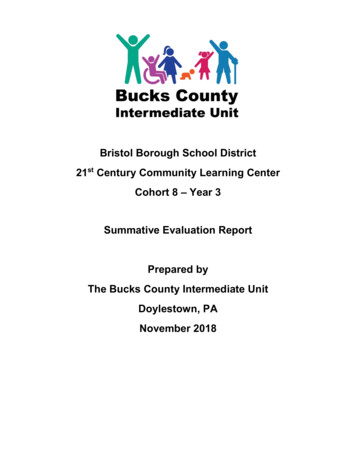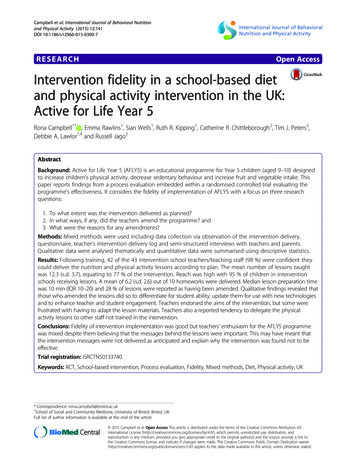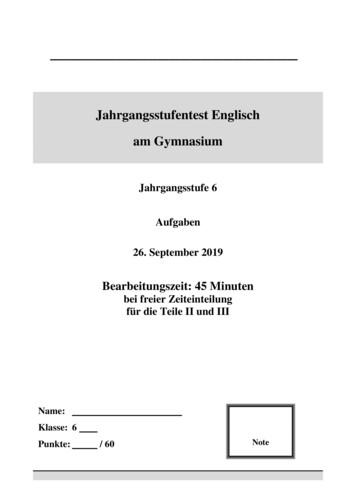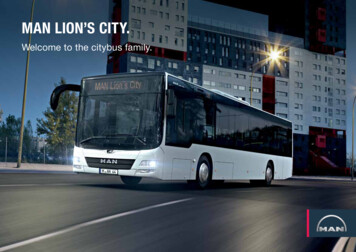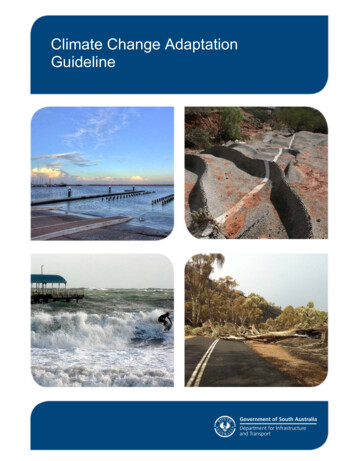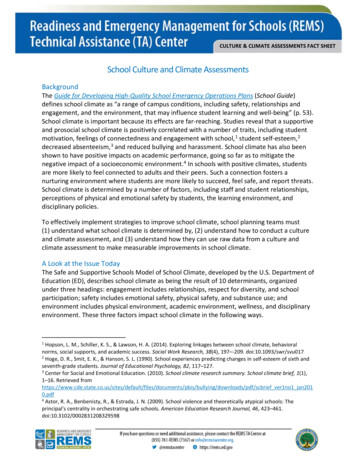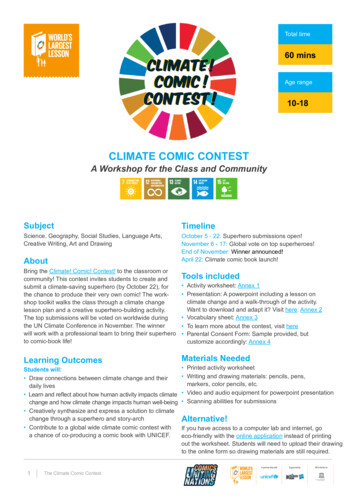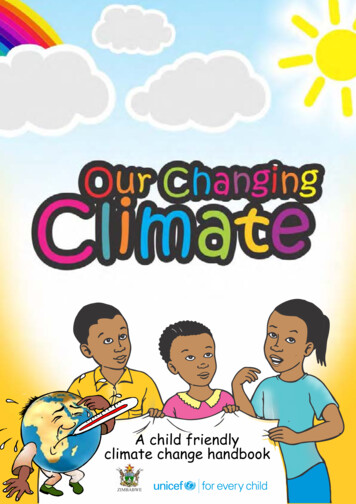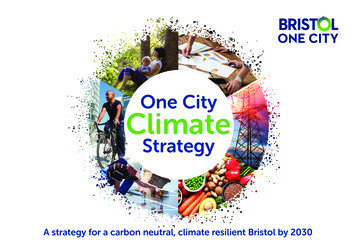
Transcription
One CityClimateStrategyA strategy for a carbon neutral, climate resilient Bristol by 2030Bristol One City Climate Strategy A strategy for a carbon neutral, climate resilient Bristol by 20301
ForewordFrom the One City Environmental Sustainability BoardWe are facing a climateemergency. As a citywe need to act now toreduce direct and indirectcarbon emissions to netzero. We need to prepareand adapt to deal withthe projected impacts ofclimate change.In the One City Plan, Bristolcommitted to becoming carbonneutral and climate resilient by 2030.To achieve this, over the next decade,we need to radically rethink how welive, work and invest in the city.We also need action regionally,nationally and internationally.This provides an opportunity to takea collaborative, inclusive and citywideapproach to make this a fair transition.As Bristol’s EnvironmentalSustainability Board, we are proudto lead this transition for the city.Representing a range of organisations,we have come together to set out ourshared vision in this strategy.Given Bristol’s strong history indelivering climate action, we areexcited to work hand in hand acrossthe city to continue to lead the way.We will move faster than the nationalaverage, learning with other cities onour journey.Bristol One City Climate Strategy A strategy for a carbon neutral, climate resilient Bristol by 2030This strategy sets the vision for wherewe need to be in 2030 based onsound science. We would like to thankour colleagues on Bristol’s AdvisoryCommittee on Climate Change fortheir review and challenge of theevidence for Bristol.We recognise that achieving our visionwill not be easy. There are entrenchedmarket and wider forces that willsupport existing fossil-fuel dependent,consumption-based systems. Wewill need to show strong leadershipto create opportunities for all toparticipate in the benefits of changewith its costs shared fairly.We have an exciting opportunity toaddress the challenge of climatechange whilst also delivering newhomes, reducing inequalities, creatinga city with more green spaces, placesfor our children to play, cleaner air,jobs and opportunities for all.Cities are complex places. We knowthat no single organisation, nor eventhe organisations that make up theEnvironmental Sustainability Boardcan deliver the scale and pace ofchange we need alone.This strategy is a call to action.We call on you, as people who live,work, visit and invest in Bristol, to joinwith us on this exciting decade oftransformation.We will engage widely to understandhow we can work together to achievethe ambitions set out in this strategy.However, this does not mean that anyorganisation or individual should waitfor a plan to be shared. This strategygives the city a focus and direction andprovides the framework within whichwe can each take responsibility andwork together to transform the city.Bristol’s One City EnvironmentalSustainability Board, February -environment-board/2
ForewordFrom the One City Environmental Sustainability BoardThis strategy is:This strategy is not:-- A strategy to set a sharedvision for Bristol in 2030.-- Co-ordinated by Bristol’sOne City EnvironmentalSustainability Board, onbehalf of the City Officeand the One City Boards.-- A strategy for the citythat will need thecollaboration of multiplepartners across the city toreach our city goals.-- Built on the currentlyavailable evidencebase. There are gaps inunderstanding and morework will need to beundertaken over time.-- Integrated. It covers bothdirect and indirect carbonemissions as well asclimate resilience.-- A delivery plan whichdetails the exact routefor the city to 2030.Detailed delivery planswill be developed andconsulted on.-- Owned by any oneorganisation, suchBristol City Council. Wewill need people fromacross the city to meetits goals.-- Perfect. We are facinga climate emergencyand we have developedthis strategy at a pacecommensurate with thechallenge.-- Static. As the worldaround us evolves interms of knowledge,legislation and policy,technology and themarket, we will adapt totake advantage of theseopportunities.Bristol One City Climate Strategy A strategy for a carbon neutral, climate resilient Bristol by 2030Environmental Sustainability Board3
Executive summaryBristol’s climate vision“In 2030, Bristol is carbon neutral andclimate resilient. We have collectivelyachieved a fair and inclusive transition;capturing the opportunities of newjobs and investment, improved health,wellbeing and education, and a betterenvironment for local people. Wehave helped lead the way to a saferglobal climate.”Introduction and approachBristol’s Environmental SustainabilityBoard has come together to developa One City Climate Strategy.We are building on Bristol’s challengesand opportunities, including theinequalities in the city, but also theexisting climate action and thenetworks and knowledge in the city.However, in this strategy we aredescribing a step change.We need urgent and transformativeaction in response to this complex,critical global challenge.Bristol’s strategy is built on a strongevidence base; setting a clear pathwayto carbon neutrality for our directemissions within Bristol. Our evidencehelps us to start the journey forreducing our wider emissions andenhancing our resilience to futureclimate change. The challenge ishuge, and we recognise that this isjust the start. As our knowledge basegrows, and as the world around uschanges, we will adapt and evolve todeliver the best outcomes for the city.Taking action on climate changepresents a great opportunity forBristol; supporting our One City Planambition to become a fair, healthyand sustainable city. A city of hopeand aspiration, where everyone canshare in its success.Bristol One City Climate Strategy A strategy for a carbon neutral, climate resilient Bristol by 2030Bristol’s climate strategyThe action that is needed to achieveour ambition is complex and multifaceted.The strategy details ten key areaswhere climate action is needed toachieve the vision for Bristol in 2030.Across each of these, we need actionat every level. These are:1. Transport: switching to significantlymore walking, cycling and zerocarbon public transport modes;converting the remaining vehiclesto zero carbon fuels; transformingfreight, aviation and shipping2. Buildings: retrofitting and buildingthem to become carbon neutral andresilient to a changing climate, callingon central government to developa supportive planning framework todeliver this3. Heat decarbonisation:implementing a carbon neutralenergy method for heating and hotwater. This is one of the areas thatwill be supported by City Leap EnergyPartnership, a radical new approachto delivering energy infrastructure inBristol4. Electricity: make our electricity useas smart and flexible as possible (tosupport electricity decarbonisationnationally), maximise local renewableenergy generation and increasesystem resilience5. Consumption and waste:responsible buying of goods andservices, alongside zero carbon fromwaste management6. Business and the economy: Bristolbusinesses move to be carbon neutraland climate resilient, capturing jobopportunities for all through thetransition7. Public, voluntary, community andsocial enterprise services: carbonneutral public and VCSE services andsupply chains that are also preparedfor future climate conditions andhazards4
Executive summary8. Natural environment: restoring, protecting andenhancing these spaces and wildlife within them as theclimate continues to change9. Food: a resilient supply chain, with food and drinkproduced locally, sustainably and moving to a more plantbased diet10. Infrastructure interdependencies: collaboration inrunning vital services to the city such as water, transport,waste, ICT and energy to improve their climate resilienceand embed carbon neutrality across different systems.Across all these key areas there will need to be theskills, funding, national action and local leadership, data,infrastructure and engagement to enable the action tohappen. Radical system changes will be required across allof these areas, at every level.Delivery, monitoring and reviewThis strategy is for all of us to deliver, and nobody needwait for permission to take action.However, in recognition that we need co-ordinated actionin some areas to deliver the scale of change required, theCity Office and the Environmental Sustainability Board willtake the lead in co-ordinating the development of deliveryplans and a clear framework for monitoring and review.Work has already started, so we will hit the ground running.We will engage widely, and work with a wide range oforganisations, community groups and individuals totransform Bristol.Bristol One City Climate Strategy A strategy for a carbon neutral, climate resilient Bristol by 20301. Transport10. Infrastructureinterdependencies2. BuildingsData3. Heatdecarbonisation9. nt8. Naturalenvironment4. ElectricitySkills7. Publicservices5. Consumption& wasteHOSPITAL6. Business &the economy5
Contents1. Vision and principles: The vision and principles thatinform and guide our strategy.2. Introduction and approach: Setting out our approachand evidence base.3. Challenges and opportunities for Bristol: Setting outthe context that this strategy will be delivered in; ourcity of passion and paradoxes.4. Our climate strategy: An overview of the strategy’sstructure.4a. Enabling conditions for change: The radicalsystem changes that we need to deliver our strategy.4b. Delivery themes: The key areas where climateaction is required in the city.5. Monitoring and review: Our approach to monitoringand review of the strategy.6. Delivery: Our initial approach to planning andimplementation for this decade of transformation.Bristol One City Climate Strategy A strategy for a carbon neutral, climate resilient Bristol by 20306
1. Vision and principlesBristol’s climate visionIn 2030, Bristol is carbon neutral and climate resilient. We have collectively achieved a fair and inclusivetransition; capturing the opportunities of new jobs and investment, improved health, wellbeing and education,and a better environment for local people. We have helped lead the way to a safer global climate.This vision is supported by a number of key Evidence-basedAchieving a just transitionis central to our strategyand critical to it achievingsuccessful outcomes.This means maintaininga democratic mandate,ensuring there areopportunities for all toparticipate in the benefitsof change with its costsshared fairly.We are all partnerswith rights andresponsibilities to deliverthis strategy for Bristol,working inclusively andcollaboratively withinthe city, as well as acrossboundaries. Goodcommunication willbe central to effectivecollaboration.Bristol will be a globalleader for rapid and radicalcity action to address theclimate emergency, takingthe initiative to createconditions for success andsupporting others on theirjourney. We will embrace theopportunities that come withbeing a first-mover in the UKand influence the nationaland international agenda.This strategy will evolveas we deliver it, learningas we go and sharingthat learning within thecity, building adaptivecapacity, innovating andlearning with other citiesand regions and adaptingas conditions change.Our strategy will buildon robust evidence fromleading science and byharnessing collectiveintelligence within thecity to understand howsystems are performing.We recognise the globalgoal for the world tolimit warming to 1.5oC,and acknowledge ourresponsibility to act.Bristol One City Climate Strategy A strategy for a carbon neutral, climate resilient Bristol by 20307
2. Introduction and approachGlobal warming and climate changepresent us with an urgent challengewe need to address. To solve thischallenge there is the opportunity totake a collaborative city-wide approachto make transformational change.As the Environmental SustainabilityBoard we have developed thisstrategy with partners, based onrobust evidence.We are facing a climateand ecological emergencyHuman activities are estimated tohave caused 1 C of global warmingabove pre-industrial levels. We arealready seeing devastating impactsof 1 C warming; this is expectedto get worse. The science on theclimate emergency is clear; we needurgent action to reduce our carbonemissions to limit global temperaturerise to below 1.5oC, and so preventdisastrous impacts. We also need toprepare for a changing climate.Global warming has already impactednatural and human systems throughincreased flooding, devastatingwildfires, storms, loss of biodiversityand extreme drought.Climate related risks to theenvironment, health, livelihoods, foodsecurity, raw materials, water supplyand economic growth will rise, evenif we manage to limit change to 1.5 Cand will be felt differently in differentregions. Populations most at risk aremarginalised, disadvantaged andvulnerable. In Bristol, some of ourmost deprived wards will be the mostvulnerable to the impacts of climatechange, including areas like LawrenceHill, where flood risk is also higher.We urgently need to transformWe are facing twin emergencies: aclimate emergency and an ecologicalemergency.Bristol One City Climate Strategy A strategy for a carbon neutral, climate resilient Bristol by 2030In addition to the climateemergency, we are also experiencingunprecedented global change dueto land and sea use change, directexploitation of species, pollution andinvasive alien species. Human actionsthreaten more species with globalextinction than ever before with thesixth mass extinction already underway.This strategy provides a way forwardfor Bristol to respond to the climateemergency. We explore opportunitiesto maximise benefits to the ecologicalemergency, but a full response will bedeveloped separately.This is a climate strategy for Bristol torespond to both:-- Mitigation: the causes of climatechange e.g. reducing greenhousegas emissions and improvingcarbon sinks; and-- Adaptation: addressing thepotential impacts of climate changee.g. actions to adapt to floods,storms or heatwaves and ongoingstresses such as sea level rise andincreasing urban heat.It is essential that we address bothclimate mitigation and adaptationtogether as an integrated response asno single option is sufficient by itself.Integrated consideration of adaptationand mitigation will allow us to identifyinterdependencies, be more efficientand minimise risk.The world is rapidly changing andthere is uncertainty over what thefuture will look like. Climate changeis likely to impact the city directlythough local extreme weather eventsand through changes further afieldwhich may impact the city indirectlyby impacting the economy and thesupply of goods and services, such asfood or public services.We need to plan for, adapt and buildour resilience for projected futurerisk in a way that provides wider cobenefits so that, no matter what thefuture looks like, our city will be betterfor our citizens. This plan is for 2030when we aim to have the plans andmitigation in place or in progress tomake us resilient for events that willoccur in 2030 and well beyond.8
2. Introduction and approachTaking this integrated approach willenable our climate action to supportBristol’s wider goal, set out in the OneCity Plan, of becoming a fair, healthyand sustainable city. A city of hopeand aspiration, where everyone canshare in its success.An integrated approach to deliveringour One City Climate Strategy willenable us to achieve so much more forBristol than simply achieving carbonneutrality and climate resilience.Working together as a city, wecan achieve a future that deliversimprovements in public health,reduced costs for public services,improved air quality, reducedcongestion, reduced inequalitiesand reduced poverty, increases injob and economic opportunitiesacross society, greater communityengagement, improved biodiversityalongside wider environmentalbenefits such as soil and water quality,and more.This will require us, as theEnvironmental Sustainability Board,to work closely with the HousingBoard, the Health and WellbeingBoard, the Learning and SkillsBoard, the Economy Board and theTransport Board, as well as with awide range of others across the city.We are committed to doing this, aswe recognise the opportunity thattackling the climate emergency bringsto tackle many more challenges in thecity. It will also require others to stepup and take action across the city.Bristol One City Climate Strategy A strategy for a carbon neutral, climate resilient Bristol by 20309
2. Introduction and approachDeveloping this strategyBristol’s One City Approach bringstogether a wide range of public,private, and third sector partnerswithin Bristol.As part of this approach, six boardshave been set up to provide leadershipon key themes. As the EnvironmentalSustainability Board, we have ledthe development of this strategy,engaging with all of the other fiveboards, recognising the cross-cuttingnature of the challenge we face.We have engagedwith over 300 peoplein the developmentof this strategy.All of the underpinning evidenceto inform this strategy has beendeveloped with advice and challengefrom the Bristol Advisory Committeeon Climate Change. This evidenceis explained in more detail in theremainder of this section.We recognise that evidence isnot fixed. As this evidence baseevolves and we gain new learning,we will use this knowledge toovercome challenges and respondto new opportunities that arise aswe implement this strategy together.We will continue to have an opendialogue and engage with individuals,households, organisations andbusinesses over the coming decade.This strategy sets the direction oftravel for Bristol as a city. A numberof detailed delivery plans will bedeveloped and work has alreadystarted on these.As we explore in section 3, we are notstarting from scratch, there is wealthof activity in the city that is alreadyunderway to support the journeytowards our vision. Businesses,organisations, communities andindividuals will need to work hand inhand to deliver a step change in termsof scale and pace of action.One City Boards and One City ApproachBristol’s AdvisoryCommittee onClimate ChangeEnvironmental Sustainability BoardClimate strategyDelivery plansClimate actionUnderpinned by evidence and engagementIn placeBristol One City Climate Strategy A strategy for a carbon neutral, climate resilient Bristol by 2030In progressStill to be developed10
2. Introduction and approachEngagementThe evidence baseInitial engagement has alreadycommenced. This is a One CityClimate Strategy; its development hasbeen steered by the EnvironmentalSustainability Board, with input fromeach of the other five One CityBoards, supported by the BristolAdvisory Committee on ClimateChange.The strategy has also been influencedby engagement with businesses,organisations, charities and peoplefrom across the city.This has comprised both 1-1 dialogue,and two major workshops forapproximately 300 people.The strategy will be delivered byorganisations, communities andindividuals working together. Theengagement and collaborationis just the start of what is needed.We will continue to have an opendialogue and engage with individuals,households, organisations andbusinesses over the coming decade.To develop the One City ClimateStrategy, we commissionedevidence-based reports on reducinggreenhouse gas emissions andon improving our resilience to theimpacts of a changing climate.The five studies that inform thisstrategy are:1. A scope 1 and 2 baseline andgap analysis. This sets out thebaseline, historic trends, as well asthe trajectory from actions that arealready planned or in place and thetrajectory to meet the UK nationalnet zero target by 2050.2. Total business emissions study.This was an assessment of scope 1,2 and 3 emissions associated withbusiness activities in Bristol. It isbased on the UK total scaled downaccording to Gross Value Added ofindustry sectors in Bristol.Bristol One City Climate Strategy A strategy for a carbon neutral, climate resilient Bristol by 20303. Household consumptionemissions study. This was a study,based on expenditure, of direct(in city) and indirect (out of city)emissions associated with theproduction of goods and servicesconsumed within households inBristol.4. Net zero by 2030 scope 1 and 2study. This study provides a detailedlook at emissions from Bristol’suse of energy, transport and wastemanagement in the city and actionsneeded to get to net zero by 2030.5. Preliminary climate resiliencestudy. This comprised a highlevel analysis of the city’s hazardexposure along with addressingvulnerability of the city’s keyphysical, social and economicassets to physical climate risk.The climate mitigation evidence baseis made up of four reports. Studies 1-3work to establish a baseline of currentemissions in Bristol. This includesthe direct emissions from energy,transport and waste in the city (scope1 and 2) and consumption-basedemissions from the supply of goodsand services from the wider world,such as food, clothing, electronicsand surface and air travel (scope 3).Building on the baseline in study 1,study 4 analyses the scale and natureof changes needed in the city to reachnet zero scope 1 and 2 emissions by2030. It details the conditions requiredto secure those changes, and outlinesthe actions likely to be required tocreate these conditions.Studies 3 and 4 highlight the scale ofthe challenge for Bristol to achievecarbon neutrality. We will needeconomies all over the world todecarbonise at the same speed aswe reduce our own direct emissionsin Bristol. This will be challenging,but we can use our buying powerto effect change, and demonstratewhat is possible by reducing our ownemissions.11
2. Introduction and approachThis evidence is described in moredetail in the sections that follow.The findings of this evidence basehave fed into this One City ClimateStrategy. The evidence base has beenreviewed by the independent BristolAdvisory Committee on ClimateChange (BACCC), who note:“The BACCC welcomes thedevelopment of a One City ClimateStrategy, which sets out an ambitiousplan to try to achieve the goal ofBristol being carbon neutral andclimate resilient by 2030.The Committee understands thatdecarbonisation and adapting toclimate change will not be easy, andwelcomes this important first step.In line with the requirements of aclimate emergency, these reportshave been developed rapidly and withlimited resources, with the intentionof catalysing urgent action. As suchit provides a good evidence basefrom which to get started, whilstrecognising that in some areas moreevidence is needed, and this shouldbe brought in to decision-making as itbecomes available. The focus shouldnow shift to developing the urgentnext steps that are needed in areas liketransport and heating.The BACCC looks forwardto continuing to work withlocal government and city partnersand to advise on the development ofthe evidence base and delivery plansin order to help the city achieve itsclimate change ambitions.”Bristol One City Climate Strategy A strategy for a carbon neutral, climate resilient Bristol by 203012
2. Introduction and approachGreenhouse gas emissionsbaselineThe evidence base provided in studies1-3 provide a baseline assessment ofgreenhouse gas emissions for Bristol.Each of the three studies overlaps withone another to provide a picture ofBristol’s emissions in full. A high-levelsummary of the results from eachstudy is given below.1. A scope 1 and 2 baseline andgap analysis and 4. Net zero by2030 scope 1 and 2 studyAccording to this study, direct energyuse, transport and waste managementemissions in the city totalled 1,600ktCO2e in 2017. This baselinedoes not include the value chainemissions of these activities and doesnot cover land use, agriculture, andforestry, which are defined as scope1 emissions sources Greenhouse GasProtocol for Cities.The study identifies that the evaluateddirect emissions have decreased by36% since 2005. However, to reachthe city’s target of a carbon neutral2030, the rate of reduction will needto be 1.6 times that of the previouslyobserved rate.Bristol One City Climate Strategy A strategy for a carbon neutral, climate resilient Bristol by 20302. Total business emissions studyIn a study of business relatedemissions in Bristol, scope 1, 2and 3 emissions in 2016 totalled 5,000ktCO2e. The study identifiedthat approximately half of all Bristolbusiness related emissions originatein supply chain activities. As such, inorder to reach the carbon neutral2030 target, we would needeconomies all over the world todecarbonise at the same speed as wereduce our own direct emissions inBristol. This will be challenging, butsignificant attention must be paid toreducing the value chain emissions ofeconomic activity in the city.Production (predominantly generationof energy), manufacturing, distributionand the provision of public servicesaccount for 82% of Bristol’s businessand economy footprint. Servicebased sectors such as finance, realestate and consultancy account formuch smaller proportions of the city’sbusiness emissions.Public services account for 14%of emissions, providing a greatopportunity for public sector leadership.3. Household consumptionemissions studyThis study established that in 2016,the household consumption ofgoods and services by citizens ofBristol resulted in approximately4,000ktCO2e of greenhouse gasemissions. This study takes intoaccount the supply chain emissions ofall goods and services consumed aswell as any direct emissions associatedwith their consumption. Themethodology followed is aligned withthe assessment of business emissions.Of this footprint, energy consumption,personal vehicle use, and theproduction of food and drinkaccount for the highest proportionof emissions at 27%, 20% and 14%respectively.13
2. Introduction and approach5. Preliminary climate resilienceassessmentIn the preliminary climate resilienceassessment, an evidence base wasgathered on physical climate risk,based on an initial understanding of:-- Climate hazard exposure, and howthis is projected to change in thecoming decades on the basis of thebest climate science;-- The sensitivity of the physical,social, environmental andeconomic systems in Bristol tothese hazards; and-- Adaptive capacity, which is theability of systems, organisations orpeople to adjust to events, respondto consequences or take advantageof opportunities.Climate hazardsThe future climate is not certain, andwe should be planning for a range ofdifferent emissions scenarios. Whilstthis is a strategy setting a pathway to2030, we recognise the need to lookfurther into the future to consider thepotential climate hazards we face ifwe don’t take action now. Looking outto 2080, when today’s school childrenwill be reaching retirement, we canset ourselves on course for a moreresilient future. Most infrastructurelasts for decades, if not hundreds ofyears, so investment decisions madein 2030, will still be being felt in 2080.Under a high emissions scenario, by2080, Bristol could expect to see:Climate change is a complexchallenge. We recognise theinterconnected and global natureof the world, which exposes Bristolto potentially catastrophic climaterisks arising well beyond the city’sboundary. This evidence base wasmainly focused on the projected localimpacts within our city boundaries.Bristol One City Climate Strategy A strategy for a carbon neutral, climate resilient Bristol by 2030Sea level on Bristol’scoastline is projectedto increase by up to 72cmWinter precipitationrate is projected toincrease by up to48%Summer maximumtemperature is projectedto increase by over 9 CBy 2080, summer precipitationrate in Bristol is projected todecrease by up to68%There is projected to be a reductionin likelihood of other hazards, suchas extreme cold. However, we needto make sure we are still prepared forthem.Physical, social and economicimpacts of extreme weatherThe climate hazards identified herecould have very serious impacts forthe people of Bristol.Of each of the climate hazards, weunderstand the spatial distributionof flooding best, and therefore thepotential physical impacts are clearer.Temple Meads station), causingimpacts to livelihoods, disruptions toour daily lives and a risk to life. Theseimpacts will get progressively worseto 2080.Whilst we know less about the spatialdistribution of extreme heat anddrought, we know that the physicalimpacts can be serious.The potential impacts to our peopleand public services are wide ranging.We can learn and adapt from eventssuch as the 2003 heatwave in Europe,where hundreds died.Our food system is at risk of shortagesof supply and increased costs,particularly given the global nature ofthe supply chain.Our wider economic supply chainis also at risk, with clothes andelectronic equipment, being the otherareas particularly at risk.This evidence base is part of thefoundations of this climate strategy.We know that there are risks tohomes, businesses, schools,community assets, and criticalinfrastructure (including, for example14
3. Challenges and opportunities for BristolIntroductionOur cityBristol is a city of paradoxes. It isa city leading in many areas ofclimate action, but not everyone isyet engaged. Bristol was the first UKcity to develop a climate strategyin 2004, and since then the cityhas been a leader in the UK andEurope delivering on progressivelymore ambitious targets. As the firstEuropean Green Capital in 2015 andthe UK’s first council to declare aclimate emergency in 2018, Bristolis a leading voice in the response toclimate change.People of Bristol are increasinglyconcerned about climate change(88% reported being concerned orvery concerned in 2019, a continuingupward trend).Bristol is a place where an increasingnumber of people want to live, workand study. Bristol’s
- Built on the currently available evidence base. There are gaps in understanding and more work will need to be undertaken over time. - Integrated. It covers both direct and indirect carbon emissions as well as climate resilience. This strategy is not:-A delivery plan which details the
